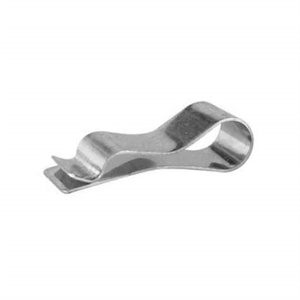OEM Custom Spring Steel Clips Tension Clips Metal
Spring steel clips are a type of fastener that uses spring steel as the material. They are often used in place of traditional fasteners like screws or nails for a variety of applications. Spring steel clip have a unique design that allows them to exert a strong compressive force on the materials they are fastening. This compressive force ensures a secure connection that is often more effective than traditional fasteners.
Spring steel clips are beneficial in many ways. They are easy to install, often without the need for tools, saving time and effort compared to traditional fasteners. They are also cost-effective, as they can be mass-produced and are relatively inexpensive. Additionally, spring steel clips can be designed to have specific functions, such as holding objects together or compressing materials, making them versatile in various applications.
Common applications for spring steel clip include fastening sheet materials together, such as in the construction of signs or notices. They are also used to fasten components in place, such as in the assembly of furniture or electronic devices. Additionally, spring steel clips are often used to secure objects to each other or to a surface, such as in packaging or shipping. They can also be used to compress materials or components to create a tight seal or to improve their performance.
Spring steel clips are available in various shapes and sizes, depending on the specific application. They are typically made from high-quality spring steel that is durable and corrosion-resistant, ensuring longevity and performance in a wide range of environments. The spring steel material allows the clips to maintain their strength and elasticity over time, ensuring reliable fastening for long-term use.
When customizing Spring Steel Clips, several important factors need to be considered:
Application Scenarios and Purposes
Identify where clips will be used, such as for securing cables, piping, components, or other specific items.
Different application scenarios have different requirements on the shape, size, clamping force and corrosion resistance of the clamp.
Characteristics of clamped objects
Size, shape and material of the object being clamped.
For example, clamping of soft objects may require protective measures on the clamping surface of the clamp to avoid damage; Clamping larger objects requires larger openings and greater clamping force.
work environment
Environmental conditions such as temperature, humidity and exposure to chemicals.
If working in high temperature environment, spring steel with high temperature resistance shall be selected; In wet or corrosive environments, rust and corrosion resistance treatment of clamps shall be considered.
CLAMPING FORCE REQUIREMENTS
Determine the amount of clamping force required to ensure that the clamp will hold the object securely without excessive compression and damage.
Installation mode
Consider whether clamps are screwed, welded, clamped or otherwise installed.
The manner in which it is installed affects the design and ease of use of the clamp.
fatigue life
If the clamp needs to be used frequently or is under stress for a long time, its fatigue life needs to be evaluated to ensure its reliability and durability.
Precision and tolerance
The manufacturing accuracy and tolerance range of the clamp shall be determined according to the accuracy requirements of the specific application.
